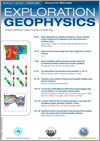
Exploration Geophysics
Volume 43 Number 2 2012
EG12008 Global optimisation by simulated annealing for common reflection surface stacking and its application to low-fold marine data in southwest Japan
We show the application of simulated annealing to optimise our estimation of the parameters in the common reflection surface (CRS) stack method. This approach using numerically modelled data and multichannel marine seismic data around the Median Tectonic Line in Japan provides a clear seismic profile with a high signal-to-noise ratio.
EG12014 Robust inversion using biweight norm and its application to seismic inversion
This paper describes the application of Tukey’s Biweight norm using the IRLS (iteratively reweighted least squares) algorithm as a robust inversion in seismic application and shows its possible improvement in robustness over the l1 norm inversion when dealing with data having many outliers.
EG12015Elastic modelling in tilted transversely isotropic media with convolutional perfectly matched layer boundary conditions
In this study, we developed a forward modelling algorithm with the staggered-grid finite-difference method. The elastic wave propagation in 2D tilted transversely isotropic media is well simulated using this algorithm. We also implement convolutional perfectly matched layer absorbing boundaries in our algorithm in order to handle the artificial boundary reflection efficiently.
EG10015An enhancement of the formation factor parameters ‘a’ and ‘m’
The use of incorrect values of the formation constants a (tortuosity factor) and m (cementation exponent) in Archie’s water saturation equation can result in the overlooking of potential producible zones. This work illustrates a simple method of calculating a and m that is dependent on sonic transit time and bulk density, and on knowing one cementation exponent value from core measurements.
EG11048 Sensitivity cross-sections in airborne electromagnetic methods using discrete conductors
Using a discrete conductor model it is possible to generate a cross-sectional image that shows the sensitivity of different airborne electromagnetic systems. This can be used to estimate the depth and width of investigation and can therefore be used to determine the optimal line spacing of airborne electromagnetic surveys.
EG11044 3D inversion of SPECTREM and ZTEM airborne electromagnetic data from the Pebble Cu–Au–Mo porphyry deposit, Alaska
This case study compares 3D inversion results from SPECTREM 2000 fixed-wing time-domain airborne electromagnetic (AEM) and ZTEM airborne audio-frequency magnetics (AFMAG) systems flown over the Pebble Cu–Au–Mo porphyry deposit in south-western Alaska. Both 3D inversions recover conductors coincident with alteration associated with both Pebble East and Pebble West.
EG11045 A network extraction tool for mineral exploration: a case study from the Wopmay Orogen, Northwest Territories, Canada
Network extraction is a routine applied to magnetic data to identify lineaments (e.g. faults and dykes). When these extracted lineaments are used in conjunction with existing geophysical and geological data, vectors for mineral potential may be identified. Network extraction was successfully applied to an aeromagnetic data set from Northwestern Canada.
EG11040Subsurface fracture characterisation using full polarimetric borehole radar data analysis with numerical simulation validation
The polarimetric borehole radar has the ability to characterise subsurface fractures. Nine fracture sets were characterised into four category fractures depending on polarimetric analysis of alpha, entropy and anisotropy decomposition. Validation of these results was implemented by numerical simulation for a synthesised fractures property using the Finite Difference Time Domain method.

